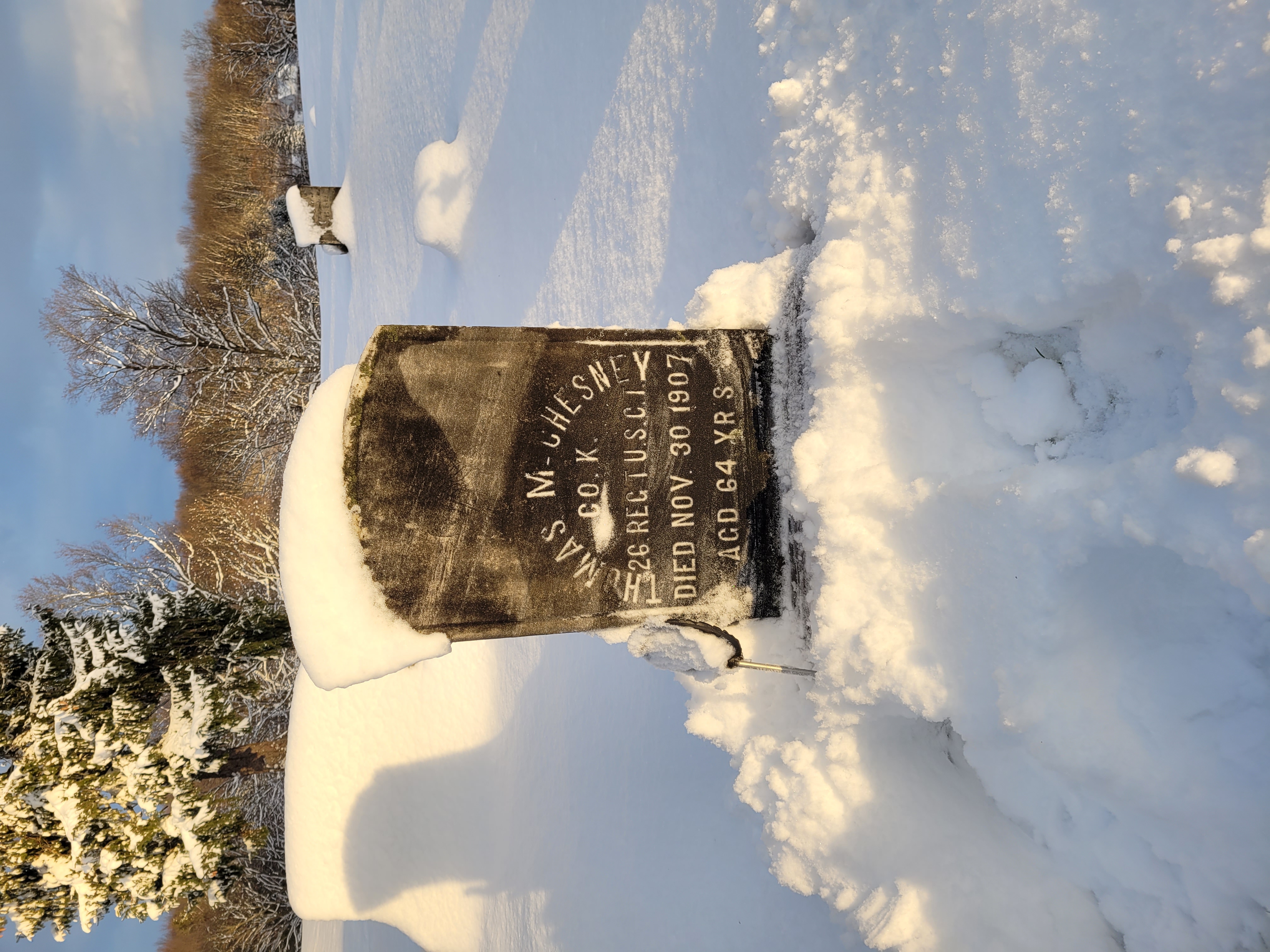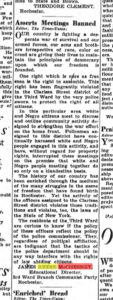[Note- The goal of the PBFT project is to show the connections between the families, so I had to break my own rules when I added this branch. In fact, this is it’s own tree as it follows the African-American families that use to live in the area. I wanted to write this up for my 2021 February column as it is Black History Month, and I hope by getting this out there, some family researchers can push this forward. So here is an expanded version of the February column.]
If you happen to walk around the Mt. Pleasant Cemetery you might notice a couple headstones with the notation of U.S.C.T or US Colored Inf., which stands for the United States Colored Troops. The headstones belong to the brothers Thomas and Sylvester McChesney. A look into their history cracks opens the door to to history of African-Americans in Port Byron and Mentz. At best, this article might be considered a survey of those African-American families that called Port Byron home, with the hopes that more might be done. Village Historian Dawn Roe has done some excellent research into the military history of all the village’s Black soldiers who served in the USCT.
Thomas and Sylvester were the sons of Thomas McChesney and his wife Jane Smith. Thomas the senior may have been from Albany County, although the first record I can find for him is in 1840 Herkimer County. All the eight McChesney children were born in Manheim in Herkimer County, although most articles just say Little Falls. They moved west to Port Byron between 1850 and 1855. I checked the 1850 census to see if there was a Black community here and found a total of twenty-five African-American folks in the area at that time.
One of those families were the TenEycks with Phillip and Sarah as the parents. The TenEycks were more a Montezuma family but I found their 15-year-old daughter Josephine working as a servant for William Halsey, the prominent Port Byron businessman. In one of those “huh?” genealogical moments, I also found Josephine’s sister Cornelia working for a Edward Halsey in Seneca County. I have yet to prove it, but my guess is that there is a Halsey connection somewhere. Josephine would later marry a John Wesley Freeman, who was listed as being born in Connecticut. John was the son of Electra Freeman, who is shown as a widow in 1860. John and Josephine would have a large family of eight. Their youngest daughter Edith would later be mentioned in the newspapers as the adopted daughter of Tom and Jane McChesney even though her father was still alive at the time. It might be that the families thought it best to have Edith move in with the McChesneys as Josephine had died shortly after Edith’s birth.
The McChesney’s eldest daughter, Vanzellia, married Henry Cooper. This union is significant in Port Byron history as their son Lawrence Cooper would marry Florence Smith, and they would have fourteen children. One of these, Bertha, would marry Benjamin White in 1919. Benjamin would later go onto become Mayor of the village. Long time readers might recall a 2019 column where I suggested that Bertha’s brother Albert was the young man seen in a postcard taken at the Lock 52 market on the canal. (This column REALLY upset some folks as they really wanted the picture to be of a young Ben White.) Vanzellia’s other daughter, Florence, would marry a William Reese who was from the Homer, NY area. Later around the turn of the century (1900), Vanzellia’s brother Philander would move to Cortland County and live with William Reese. His son, James Reese McChesney, would become a prominent leader in the Black community in Rochester, and his letters from the 1943 newspaper sound as if they were taken from recent events.
In Vanzellia’s 1917 obituary there is the odd suggestion that she was the sister of a man named John Stewart, who had died in 1904. At one time John had been a slave, but he had escaped and settled near Port Byron before the Civil War. I could find no connection between the Stewart and McChesney families, but I did find a Black man named Daniel Stewart living in Port Byron in 1850. It is one of those odd occurrences that make you think, “hum!” Did John settle here because he had family here? John was listed as being from Virginia, and when John died, the local paper noted his passing calling him “the old landmark” and that he bore the scars from his slavery. When Black men were finally allowed to serve, John Stewart enlisted and served in the USCT 20th Regiment. (Phillip TenEyck also served in the 20th.)
John was one of nine African-American soldiers that Dawn Roe has identified as being from our village and town. There are also five white soldiers who also served in the USCT in leadership roles. However John Stewart was the only man who was born in the south. The rest were men of the north. The St. James AME Church in Ithaca has a monument dedicated to the soldiers of the 26th. Here is a very good article about the 26th.
Benjamin White is an interesting study. His father Henry was born in Ontario, Canada, as was Benjamin. They lived in Windsor, which is right across the river from Detroit. Benjamin moved to Detroit and later came to Syracuse where he met Bertha. Although he was born a Canadian, he enlisted in the US Army for WW1. He married Bertha in 1919 and moved to Port Byron, where he lived out his life. Benjamin said that he went back to visit his father once a year.
Thomas McChesney died in 1907, Philander in 1916, Venzellia Cooper in 1917, and Sylvester in 1934. When he died, Sylvester was living with Lawrence Cooper on King Street. The Coopers and the Whites lived right next to each other.
Surprisingly there are few family researchers working on these groups and there are some very interesting connections to chase down, such as were the Freeman and McChesney families actually related? Was there a connection between the Stewart and McChesney groups? One of the things I did was to download the census into spreadsheets, which allows me to sort by things like race. Seeing all the Black families in one group helps to make some connections, and it led to some real ah-ha moments.

